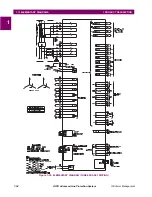
1-38
ALPS Advanced Line Protection System
GE Power Management
1.9 PHASE IDENITIFIED CHANNEL SCHEMES
1 PRODUCT DESCRIPTION
1
1.9 PHASE IDENITIFIED CHANNEL SCHEMES
1.9.1 DESCRIPTION
This feature applies to the ALPS with single phase tripping model only.
The ALPS with Single Phase Tripping models on series-compensated lines include the ability to use multiple permissive
channels in phase identified channel schemes to improve the phase selection capability of the protection. The model num-
bers that include this feature are: ALPSDA1
XXXXXXXXX and ALPSDB1XXXXXXXXX (where X is any valid character) with
firmware version V0004.03AA21 or higher. The use of phase identified channel schemes improves the performance of the
protection scheme in single phase tripping applications where inter-circuit (“cross-country”) faults are possible.
1.9.2 INTER-CIRCUIT FAULTS
The protection of double circuit transmission lines presents a challenging problem when single phase tripping is required.
Consider the simple system shown in Figure 1–22: INTER-CIRCUIT FAULT EXAMPLE below.
Figure 1–22: INTER-CIRCUIT FAULT EXAMPLE
For the fault condition shown, the protective relays on both lines at Station R will detect an AB to ground fault. At Station S,
the relay on the protected line will detect an AG fault, while the relay on the parallel line will detect a BG fault. Note that as
the fault location is moved away from the bus at station S, the relays at Station R will detect the correct single line to ground
fault. If suitable precautions are not taken, the condition of Fig. A-1 will result in the tripping of all three phases of both line
at Station R, and proper single pole tripping at Station S. The operation of the relays at Station R is due to the fact that they
must rely on the local phase selection to determine the fault type and which phase or phases to trip. The solution to the
problem is to use the fault type information from both the local and remote ends of the line to determine the proper tripping
mode. This solution requires multiple communications channels to transmit the information between the substations. The
ALPS relay offers two phase identified channel solutions to the problem. The first requires the use of two permissive chan-
nels with encoding; the second requires the use of four permissive channels. The operation of these schemes is described
in the following section.
1.9.3 TWO CHANNEL PHASE IDENTIFIED CHANNEL LOGIC
a) PILOT TRIPPING
The local faulted phase determination uses the same algorithms as other ALPS relays. The permissive keying is super-
vised by the fault detecting functions (phase and ground distance, GDOC) and the local fault type determination algorithm.
The channel keying is based on the local fault type as shown in the following table.
The receipt of either channel will be used as the permissive signal in the scheme logic. This allows the relay to determine
that the fault is within the protected line. In addition to the permissive signal, the receiver inputs will be compared with the
selected local fault type per the following table to determine which phase(s) to trip.
Table 1–7: CHANNEL KEYING FOR PILOT TRIPPING (TWO CHANNELS)
LOCAL FAULT TYPE
XMTR #1
XMTR #2
AG, BC, BCG
X
BG, CA, CAG
X
CG, AB, ABG, 3PH
X
X
NOTE
ST
A
TION
R
ST
A
TION
S
PARALLEL LINE
PROTECTED LINE
BG
AG
Содержание ALPS
Страница 2: ......
Страница 4: ......
Страница 182: ...5 20 ALPS Advanced Line Protection System GE Power Management 5 5 MOB TESTING 5 FUNCTIONAL TESTS FACTORY SETTINGS 5 ...
Страница 200: ...6 18 ALPS Advanced Line Protection System GE Power Management 6 5 ZONE REACH TESTS 6 FUNCTIONAL TESTS USER SETTINGS 6 ...
Страница 346: ...D 4 ALPS Advanced Line Protection System GE Power Management D 1 KEYPAD MENUS APPENDIXD D ...
Страница 352: ...F 2 ALPS Advanced Line Protection System GE Power Management F 1 WARRANTY INFORMATION APPENDIXF F ...
Страница 366: ...xiv ALPS Advanced Line Protection System GE Power Management INDEX INDEX ...






























